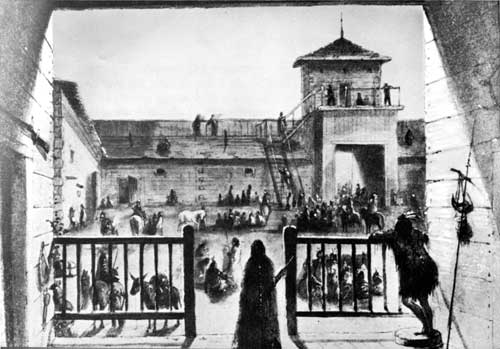|
FORT LARAMIE National Historic Site |
 |

The Interior of Fort William in 1837.
From a painting by A. J. Miller in the Walter's Art Gallery.
Fort William, the First "Fort Laramie," 1834
The advantages of the site were readily apparent to William Sublette and Robert Campbell, when, in 1834, they paused en route to the annual trappers' rendezvous to launch construction of log-stockaded Fort William. This fort, named for Sublette, was the first fort on the Laramie.
In 1835, Sublette and Campbell sold Fort William to Jim Bridger, Thomas Fitzpatrick, and Milton Sublette, and a year later these men in turn sold their interests to the monopolistic American Fur Co. (after 1838, known officially as Pierre Chouteau, Jr. and Company).
Rev. Samuel Parker and Dr. Marcus Whitman, early missionaries to Oregon, traveling with a company of fur traders, paused at "the fort of the Black Hills" in July 1835. Reverend Parker has left a vivid description of activities at the fort, including near-fatal fights between drunken trappers, a council with the chiefs of 2,000 Oglala Sioux gathered at the fort to trade, and a buffalo dance, regarding which Parker commented, "I cannot say I was much amused to see how well they could imitate brute beasts, while ignorant of God and salvation . . ."
Marcus Whitman again traveled westward in 1836 with a fur traders' caravan, this time accompanied by his bride and Rev. and Mrs. Henry H. Spalding. The ladies, the first to travel the Oregon Trail, were extended all possible hospitality at Fort William. Especially remembered were chairs with buffalo skin bottoms, no doubt a most welcome change from the ordeal of saddle or wagon box.
To an artist, A. J. Miller, who traveled with Sir William Drummond Stewart, we are indebted for the only known pictures of Fort William. Made during his visit to the fort in 1837, these paintings depict a typical log stockade which Miller's notes describe further as being
of a quadrangular form, with block houses at diagonal corners to sweep the fronts in case of attack. Over the front entrance is a large blockhouse in which is placed a cannon. The interior of the fort is about 150 feet square, surrounded by small cabins whose roofs reach within 3 feet of the top of the palisades against which they abut. The Indians encamp in great numbers here 3 or 4 times a year, bringing peltries to be exchanged for dry goods, tobacco, beads and alcohol. The Indians have a mortal horror of the "big gun" which rests in the blockhouse, as they have had experience of its prowess and witnessed the havoc produced by its loud "talk". They conceive it to be only asleep and have a wholesome dread of its being waked up.
The fur traders came to be more and more dependent upon the fort on the Laramie as a base of supplies and a refuge in time of trouble. Similarly, early travelers and missionaries found it a most welcome haven in the wilderness. In 1840, the famous Father de Smet paused at this "Fort La Ramee" where he was favorably impressed by a village of Cheyennes.

|

|
|
Last Modified: Sat, Dec 9 2000 10:00:00 am PDT |


